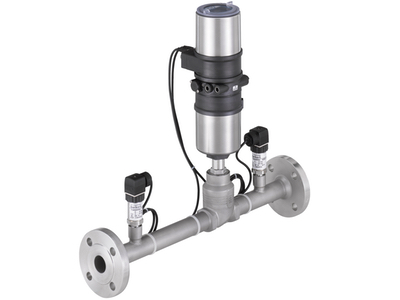The most significant advantages of pneumatic or vacuum conveying over mechanical conveying include:
- Reduced maintenance due to the lack of moving parts
- Improved operational environment with no dust due to the fully enclosed design
- High flexibility of the transfer route
- The possibility to carry out physical or chemical processes during the conveying process
- The ability to convey air-sensitive materials using an inert gas, such as nitrogen, to prevent oxidation.
Optimising the transport flow
The process of transporting materials often requires the destination to change, for example when a storage container is full and the product is diverted to the next container.
The volume of air in the transport system is crucial to maintaining the product in suspension and making changes to the required volume must be matched by a suitable adjustment to the airflow in order to keep the product in suspension and avoid unnecessary wear to the pipework or degradation of the conveyed material.
The same applies to making a change to the product itself; this will also require an adjustment to the airflow to ensure the correct air velocity and product quality are maintained.
However, the way in which the air is introduced to the conveying system can have a significant effect on the system design and the power requirements to operate it.
More traditional “blow pot” solutions are giving way to systems that use multiple air injection points to provide a uniform air flow throughout the system. Increased levels of computer control and monitoring allows new installations to be delivered with much lower power requirements, which form a significant proportion of the operating costs.
Improving productivity
The key to managing these power requirements, and the subsequent costs, is to implement a control system that can react to changes in the internal volume of the transport system, maintaining the optimum airflow.
This approach has resulted in the industry shifting from steady state systems towards non-steady state systems. The ability to operate a plant with product quality variation without stopping the process due to plugged pipes can greatly improve the productivity of the plant and help to reduce the operator’s total cost of ownership.
To implement such a system requires an airflow controller that can continually assess the demands of the system and provide feedback signals for the compressors. Integrating such an air flow controller with a pneumatic conveying system that has had little or no control in the past, can be challenging.
However, recent developments in data networking, connectivity and microprocessor control have been heralded as Industry 4.0 and the Internet of Things (IOT). Advances in design technology and the reduction in costs have resulted in a huge increase in the amount of technology available to measure and control industrial processes.
When applied to pneumatic conveying it enables the continuous measurement of material mass flow rates and the adjustment of air flow rates using computer algorithms to both within an optimum range. Furthermore, this data can be collected and analysed centrally to ensure that the plant continues to operate at the best efficiency.
Maximising efficiency
One possible solution for delivering improved efficiency is a closed loop controller that features a flow sensor, a process controller and a control element, all in one unit. As such, a compact and flexible design would enable the flow controller to be installed easily and provide accurate management of the compressors.
Bürkert specialises in developing solutions for customers in a diverse range of industries, delivering flow control systems for a wide variety of applications. The latest offering addresses the issues associated with creating a standalone control system for pneumatic conveying, all in one product.
The Type 8750 flow rate controller provides a solution that can reduce operating costs and improve productivity through better management of the compressors.

The pneumatic seat valve compensates for the air leakage across the rotary valve that introduces the solids to the conveying air stream. The Type 8750 can store the flow leakage curve of each rotary valve so that for any given inlet pressure the 8750 knows how much additional air is required to compensate for the air lost from the system by the rotary valves.
The flow rate control system consists of an ELEMENT continuous control valve (Type 2301) with a compact process controller (Type 8693) and two pressure transmitters, (Type 8323).
These components are supplied as an assembled system that negates the requirement for a separate flow meter. Using the pressure difference across the valve and the given density and temperature of the medium, a nominal flow can be calculated, providing the flow characteristics of the valve to the process controller.
The volume flow can then be adjusted by changing the stroke of the control valve. The control valve serves as an orifice plate to connect pipework so installation is straightforward and there is far less of a pressure drop compared to alternative arrangements.
Creating flow control systems can be a complex issue, especially if you are dealing with the pharmaceutical or the food and beverage industries. The standards that need to be met when designing and constructing processing infrastructure can be very stringent.
Bürkert has been designing and installing flow control systems for these, and many other industries, for 70 years and in this time has developed an in-depth knowledge of the requirements for success.

